A Babirusa-rat Hybrid?
Mammalian Hybrids
|
Sir, to leave things out of a book, merely because people tell you it will not be believed, is meanness.
—Samuel Johnson
|
In the fall of 1897, a report (quoted below) appeared in many U.S. newspapers. It describes a strange animal born at the Cincinnati Zoo, a rat that had large tusks and grunted like a pig.
The only pig with recurved tusks like of the rat in the picture below is the small Indonesian pig known as the babirusa (see image at right). Thus, if this strange creature was in fact a pig-rat hybrid—a type of cross that, seemingly, has never been reported—then the specific type of pig in question would have been a babirusa (Babyrousa babyrussa).
From the Appomattox and Buckingham Times (Dec. 9, 1897, p. 2, col. 1; source), published in Appomattox, Virginia:
A Remarkable Rat
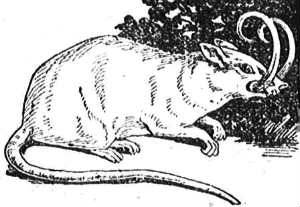 A babirusa-rat hybrid? This animal was pictured in many U.S. newspapers (source: Appomattox and Buckingham Times).
A babirusa-rat hybrid? This animal was pictured in many U.S. newspapers (source: Appomattox and Buckingham Times).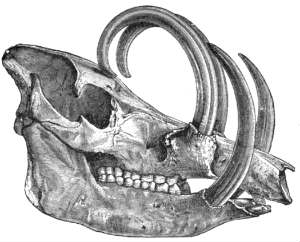 Babirusa tusks, shown for comparison with the image above.
Babirusa tusks, shown for comparison with the image above.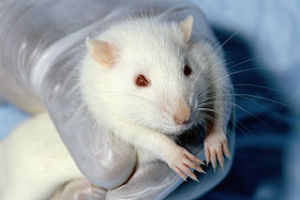 White Rat
White RatRattus norwegicus
The ordinary white rat is merely an albino brown rat (Rattus norvegicus).
There is, of course, the question of how a babirusa would inseminate a rat. Even though babirusas are smaller than most pigs, at first glance such a mating might seem impossible. However, in some crosses, even ones occurring in a natural setting, there can be very large differences in the size of the male and female. Moreover, many animals do not require penetration for fertilization, especially when the distance between the entrance to the reproductive tract and the ovary (the location of unfertilized eggs) is short, as it is in small animals (this distance is only about an inch in rats). For example, during copulation most birds simply touch their cloacae together; there is no penetration because the male has no a penis. Among birds, penises are present only in members of Order Anseriformes (ducks, swans, geese, etc.), and in a few others, such as ostriches and emus. So, even though in the present case it is unknown what actually occurred, one can imagine various scenarios. Perhaps two babirusas were confined in a crate stacked on top of the cage where the mother rat was being held. Then, perhaps they had sex and, after withdrawal, maybe the male slopped semen onto the mother rat below so that she ended up with babirusa semen in her reproductive tract. This is just one possibility, of course.
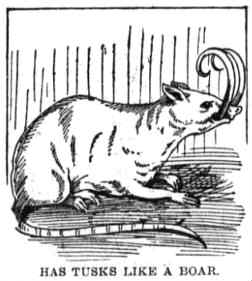 Another drawing of the same animal from a different paper (The Enterprise, published in Wellington, Ohio). Note the seemingly pig-like snout.
Another drawing of the same animal from a different paper (The Enterprise, published in Wellington, Ohio). Note the seemingly pig-like snout.
Another question is whether this case might be due to overgrowth of the incisors, a fairly common condition in mice and rats. Incisors grow continuously in rodents, but the grinding action of the lower incisors against the upper always maintains their proper length. However, overgrowth of these teeth takes a long time to develop, whereas the quoted report says that the animal in question was only a week old. Moreover, the length of the teeth pictured in the accompanying illustration far exceeds that seen in rodents with overgrown incisors and it can be seen in the picture that the teeth emerge from the sides of the mouth like tusks, not from the front as would incisors, and that they are shaped like tusks. And besides, why would abnormal tooth growth cause a rat to “grunt like a pig”?
One reader suggested this might be a case of malocclusion, a fairly common malady in rats. However, as was the case with overgrowth of the incisors, malocclusion does not produce huge tusks “fully twice the length of the head.” Nor does malocclusion cause teeth to emerge from roots at the sides of the jaw. Nor does it cause a rat to grunt.
If this animal was a pig-rat hybrid, it would be an interordinal cross (Order Artiodactya × Order Rodentia), which might lead many readers to suppose that it is too distant to be possible. However, this website lists many other interordinal crosses among mammals, some of which are quite well documented.
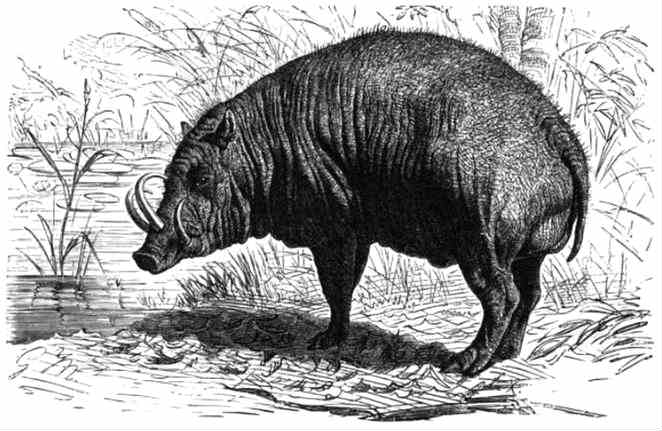 A babirusa (Babyrousa babyrussa).
A babirusa (Babyrousa babyrussa).
By the same author: Handbook of Avian Hybrids of the World, Oxford University Press (2006).
Most shared on Macroevolution.net:
Human Origins: Are we hybrids?
On the Origins of New Forms of Life
Mammalian Hybrids
Cat-rabbit Hybrids: Fact or fiction?
Famous Biologists
Dog-cow Hybrids
Georges Cuvier: A Biography
Prothero: A Rebuttal
Branches of Biology
Dog-fox Hybrids
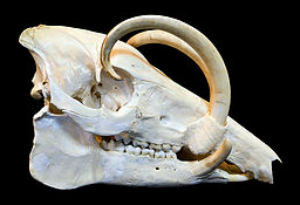 Skull of a babirusa
Skull of a babirusa